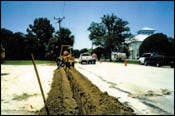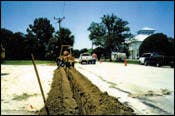By R. Paul Farrell, Jr.
Once upon a time in America it was relatively easy to build a house in a new suburb and drop a septic tank in the yard for wastewater treatment. Even today the septic tank population is growing. The sad fact that failing septic tanks are a feature of many American suburbs today makes it clear that they have been grossly misused.
Central sewers have become the solution to this pollution issue for outlying communities around the country. However, the extremely high cost of gravity sewers in certain situations has forced local authorities to seek more economic and practical solutions to this age-old dilemma of what to do with the dirty water.
One of the most successful and widely used systems is pressure sewers powered by grinder pumps. Most public health officials, developers, consulting engineers, contractors, and public works personnel have had at least some experience with pressure sewers during the 30 years since their introduction. They are in everyday use in subdivisions or other neighborhoods all over the country.
In many typical "second home" communities, all the lots are platted, roads built, and some community facilities put up initially in order to begin selling lots. This represents a large "up front" investment at the start of the project. Since only a few houses are actually built and occupied each year, resulting in a proportionally small revenue stream, the "up front" cost of gravity sewers is often prohibitive. On the other hand, if pressure sewers and grinder pumps are chosen, all of the small diameter shallow buried pressure piping system can be installed initially at very low cost per foot. The grinder pumps, which comprise the majority of capital cost, need be bought and installed only as each house is built. This is especially critical in providing affordable sewers initially to the first few houses often scattered throughout a large tract far from their nearest neighbor.
The cost difference between gravity and pressure sanitary sewers is a function of the pipe size, depth, and the necessity to "survey" gravity sewers into the ground on a precise grade. Pressure sewer pipes, besides being smaller and shallower, need not be laid on a precise grade, but can often go over rolling terrain at a nominally constant shallow depth dictated by the local frost penetration depth or, in very mild climates, by the need for protection from mechanical damage.
In steep terrain, especially up hill runs, gravity sewers very quickly become too deep to be feasible. The only answer is to put at least one pumping station on each significant uphill reach. Gravity can usually be used on the downhill sections, but the capacity of pump stations become successively larger as the piping progresses toward the ultimate discharge point.
Pressure sewers can be designed to work successfully in either situation. Appropriate attention must be paid to the need for air and vacuum release valves at significant high points in the profile, as well as at the beginning of long downhill runs discharging to atmosphere. The ability to construct sewers that follow hill and dale not only makes development affordable, but has also preserved natural rolling topography and trees.
Rock can be one of the most costly and difficult factors in construction. In the case of gravity sewers, the price per foot can easily become orders of magnitude greater than in normal soil. Bid prices as high as $500 per running foot have been submitted for 10 inch gravity sewers in solid rock. In most cases, however, contractors decline to bid altogether, or submit only on alternatives such as pressure, vacuum or STEP systems. The fact that these alternatives require dramatically narrower and shallower trenches makes them feasible in places like solid rock where gravity is literally impossible.
Locations with high groundwater, whether seasonal or year round, present other challenges in both construction and operation of gravity sewers. During construction, the work site must be de-watered by generous use of pumps and well points distributed along the proposed trench route, and powered 24 hours a day. Such de-watered soil can be very unstable and potentially dangerous. Continuous shoring and bracing are usually required. Even if these obstacles are overcome, there remains the necessity to successfully operate the completed gravity sewer for the next 40 or 50 years. Consider that once the de-watering pumps are shut down and the ground water returns the sewer must operate in what is tantamount to a submerged condition this without causing infiltration and or inflow, both notorious enemies of overall water quality goals.
One of the most desirable properties is "a place beside the water." The topographical features which create water bodies are dominated by the fact that the land almost always slopes down toward the shore. It is very expensive, environmentally damaging, and seldom satisfactory to put gravity sewers in such waterfront locations. The pressure sewer has been a real hero in these waterfront situations.
Sometimes, property is developed in a strip all along one side of a highway, road or stream. Often there are highly desirable, perhaps isolated, building lots on the "wrong side of the street." Until pressure sewers came along, these scattered choice lots were listed as "unbuildable" and might be ignored for decades. Pressure sewers bored under the stream or highway using a trenchless technology or carried overhead on a bridge crossing make such difficult sites accessible to whatever sewers already serve the strip community.
It is always desirable, and sometimes absolutely mandatory that public sewers be deep enough to serve fixtures at, or just under, the basement floor level. It often happens that when a gravity sewer is designed to serve a certain area, the basements of houses at the ends of the served streets end up just level with the sewer. If such streets are later extended further out into the country, the new houses will be too low to have basement sewer connections. The answer is to put grinder pumps in or next to these basements and create a pressure sewer district that can pump into the nearest gravity pipe or pumping station with available capacity for the additional flow.
Contrary to common knowledge, flat land is not necessarily an easy or inexpensive place to sewer. There is no doubt that in conventional gravity sewer construction, shallow trenches are the least expensive, but all flat land trenches are not necessarily shallow. In fact the only way that sewers in perfectly flat terrain can be kept shallow is by the frequent use of lift stations. The profile of such a sewer can accurately be likened to a saw tooth, more specifically a rip saw, with long down ramps (gravity runs) interrupted by nearly vertical sections (lift stations).
Considering that much flat land is coastal such as in Florida the water table tends to be high and unless gravity sewers are kept above the normal water table, the problems of underwater construction plus a permanent threat of infiltration can be enormous. On the other hand, pressure sewers are, both by definition and in practice, water tight and virtually leak free. They need never go deeper than the maximum frost penetration depth. In our example of Florida, where there is no frost penetration, the pressure sewers need be only 18 inches to 24 inches deep whatever is required to protect them from mechanical damage.
Clearly, the advantages of Grinder Pump driven Pressure Sewer Systems are numerous. The development of pumps using semi-positive displacement technology has resulted in high reliability equipment. A typical interval of more than 10 years between service calls with no interim preventative maintenance has been reported by one manufacturer. (This is based on 20 year's data and an installed base of more than 100,000 grinder pumps.) The reliability, availability, and maintainability of these "new economy" sewer systems make higher levels of sewer service possible at affordable investment levels; thus contributing directly to the public's health and quality of life.
R. Paul Farrell, Jr., PE, is a retired engineer who, after 50 years with General Electric and Environment One Corporation, consults on small community and on-site wastewater systems. Portions of Farrell's book "The Secret Life of Pressure Sewers" were excerpted for this article.
Booth 1949




